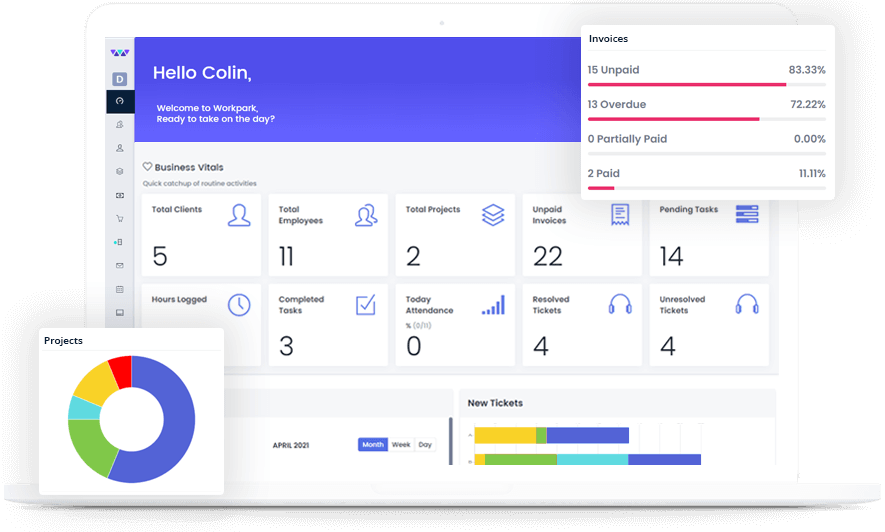
If you are somebody exploring why your business might need a business management software, chances are you fall into one of the two categories. Either you’re a passionate entrepreneur embarking on a new business endeavor – ready to steer your ship or you have been steering one for a long but over time the ever-increasing complexity in processes has led you to consider standardizing your process and bringing efficiency.
Running a business is no walk in the park, this is what we believe at Workpark; the grand ideas, creative strategies and sky-reaching goals are all easier said than done.In fact, maintaining everyday tasks, trying to keep everything on track and running smoothly actually eats up a lot of your time and energy.
These day-to-day operations are The Real Deal, they can make or break an organization and when it comes to venturing in new directions you have to be careful about not blowing up your existing operational structure.
How do you manage your business?
If the above sounds like your story then let me ask, do you make extensive use of status or catchup meetings? Sticky notes, spreadsheets, communication scattered on emails, messages on Whatsapp and calls? Do you feel work progress is generally behind schedule and sudden issues pop up blocking your entire workflow? Are there situations where people point at each other for delays or lost opportunities?
Well, then that is the story of most small businesses. In an ideal world a business should operate with the same precision as a clock and we at Workpark, believe you can reach close to that without having to master the art of clockwork. What you need is a business management system that can cover all your business needs.
These are new, simple, and cost-effective counterparts of the ERP (enterprise resource planning) systems used by large enterprises enabling them to operate much more smoothly than SMEs despite having a workforce in large numbers and spread across the globe.
How can business management software help you boost the performance and growth of your business?
Add structure and organize your work
The first key purpose that business management software serves is to set up the foundation of work at your office. It ensures that all the employees and external stakeholders are identified and the tasks or actionable items are properly listed. This creates a structure and organizes the way work takes place in your company. All the actions and data are stored in a centralized system which is always available and can help uncover trends and patterns that could not be identified otherwise.
Without having a business management system in place there is a good chance that your company data is not fully recorded and you may have information scattered across multiple spreadsheets or function-specific apps which makes it hard to store and secure for long-term use and it’s nearly impossible to generate insights from that.
Visualize, foresee and proactively tackle problems
Visualizing, anticipating, and proactively addressing challenges is a critical aspect that a business management software brings to the table. By utilizing milestones, deadlines, and cutting-edge charts that automatically translate raw data into visual representations, your business data becomes more than just numbers – it transforms into a powerful tool for informed decision-making.
Data with a deeper meaning, enables you to uncover valuable insights and anticipate potential challenges. This proactive approach is invaluable as it empowers you to identify areas for improvement and address potential bottle-necks before they appear.
Resulting in an environment where the conclusion of one task seamlessly transitions into the begining of the next enhancing the overall operational efficiency of your business.
Foster Transparency & Accountability
Decision-makers gain the ability to not only observe but also measure the performance of teams and individuals. It’s akin to having a birds-eye view of your entire organization, instantly highlighting areas that may require additional attention or even intervention.
This new level of transparency ensured by business management tools enables finding potential issues lingering in grey areas and are timely brought forward, leaving no room for ambiguity. Every unit and individual becomes accountable for their performance, transforming accountability into a motivational factor. This transparent approach not only motivates teams but also acts as a deterrent to slacking behavior, fostering a culture of responsibility, diligence and continuous improvement.
Cultivating productivity & happiness as the new company culture
Fostering a company culture centered around productivity and happiness is a key outcome of implementing a business management system. It provides transparent and well-defined plans for the future, serving as a morale booster that instills confidence in team members across all functions of the business and hierarchy.
With clear visibility into the company’s goals and a precise understanding of individual roles and scopes, employees can take ownership of their responsibilities. This clarity empowers both individuals and teams to plan their work effectively, mitigating the risk of burnout. The result is an upswing in productivity, coupled with a workforce that experiences increased job satisfaction, ultimately improving contributions to the organization’s bottom line.
Furthermore, employees feel more connected to the company’s mission, leading to a sense of purpose that transcends into daily tasks. As a result, the company culture transforms into one that not only values productivity but also prioritizes the well-being and happiness of its workforce. This dual emphasis contributes to a harmonious workplace where employees thrive, leading to a positive impact on overall company performance.
Peace of mind with clarity & control
Unlike project management tools, a business management software platform is not just limited to managing your projects or general operation tasks. It also covers the entire length of business activities such as finances, human resources, clients, sales pipeline, support tickets, internal team collaboration, etc.
You can have a full track of a client’s profile, things like sales, invoices, dues, and payments received or in case of employee payroll and other payments, attendance, employee check-ins at work and much more can be managed through a centralized system.
This translates to complete peace of mind, you don’t have to carry your business in your head all the time. Everything is just a click away and is securely stored in a much more meaningful manner.
Increased revenue and sustainable growth
With most inefficiencies straightened out; your business is now a supercharged machine, catapulting your team into peak productivity and the ripple effect is: increased overall output, a seamless workflow that translates into timely deliveries, and a satisfied customer base.
The enhanced efficiency in operations allows for an increased capacity to serve customers meaning more sales. As you meet customer demands promptly and efficiently, you can take on more projects, serve a larger customer base, and explore new avenues for expansion.
The optimized processes not only increase the quantity but also the quality of your outputs. With a well-organized and efficient workflow, your team can focus on delivering exceptional results, fostering customer loyalty and positive word-of-mouth. The result is a domino effect where higher customer satisfaction levels lead to increased repeat business and referrals.
Building Resilience: Recession & Pandemic proof business
Last but not least, your business has not only resolved existing issues but also emerged better prepared for times of crisis. It becomes adept at navigating abrupt changes, transforming its structure, and adapting to a potentially less hospitable environment. This resilience is especially beneficial in times of recessions and pandemics.
In the event of a pandemic, the digitally transformed business can swiftly transition to a work-from-home model with minimal concerns about communication breakdowns. The robust digital infrastructure ensures that teams can seamlessly collaborate, and operations continue without disruptions.
Moreover, in times of economic stress, the tools and processes already in place allow for a seamless transition to a different business model — if need be. This strategic agility becomes a key asset, allowing your business to exist for decades to come.
How is an all-in-one solution better than spreadsheets or specialized solutions?
Let’s address another concern here arising because of the range of solutions available. Let’s assume you are working on a complex project with many moving parts. In this case, your team might be on the move and they may not have a clear idea of what every other team member is doing and what is the timeline of other actions or tasks on which their task might be dependent.
Option 1 – spreadsheets:
You are required to create a manual project tracking spreadsheet with your project manager fully drowned in following up, updating it, and also trying to keep the project team well informed by calling or messaging every single member which is a big hassle and may still leave room for gray areas resulting in errors or delays.
Option 2 – Separate tools for each business function like project, accounts, HR etc:
Having specialized functions specific tools like project, accounts, HR, etc, your team might perform excellently within its scope of work or business function but may not have an exact updates what other related teams are doing in relation to the actions of mutual concerns or dependencies. Here establishing cross-department harmony is not possible unless additional resources are assigned to manually take of updating the relevant stakeholders.
- Your accounts department is completely out of sync with the project costs, expenses, and payments received or made unless manually updated by the project manager at specific intervals.
- Your HR team doesn’t know anything about the performance of your timesheet or the peace of work-based staff.
- The inventory or logistics team is not aware of which equipment is needed and when to provide it.
- You are still paying for multiple systems but still, your departments have to do manual record-keeping similar to spreadsheets. It’s just that collaboration within each department has improved but for the overall performance, your company has loosely connected islands performing better on their own, not as a whole.
Option 3 – All-in-one solution: In comparison, a comprehensive business management software would leave no gaps or underperforming areas and uplift your entire business’s productivity.
Conclusion
We cannot stress enough how small businesses today are unable to reach their true potential due to the lack of processes and systems which should be in place and one of the most important among those is the absence of a business management system. It is that one hidden factor behind the scenes that acts as the digital brain of your company. If you are using spreadsheets or even some form of function-specific solution then it’s time to migrate to a comprehensive business management solution. The COVID-19 pandemic has been a wake-up call for businesses worldwide and there is no better time to start than now.
Next: 7 best agile project management tools for small businesses in 2024
Also read:
14 effective uses of project management tools for business management
Top 5 pain points faced by project portfolio managers
What is Agile planning and how it works?
What are the 5 phases of project life cycle?
About Workpark
Workpark is a comprehensive all-in-one Business OS covering all the core business processes from sales, finance, human resources, projects, customer support to products & inventory. Specially designed for small and medium-sized businesses to help them overcome the common digital transformation challenges of complexity and high costs through a simple, easy to use, and cost-effective solution.

Ready to transform your business?
Start Your Free Trial– Get 50% Off for lifetime when you sign up!
– 7 Days Free Trial
– Assisted onboarding








